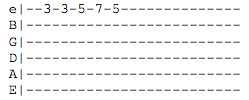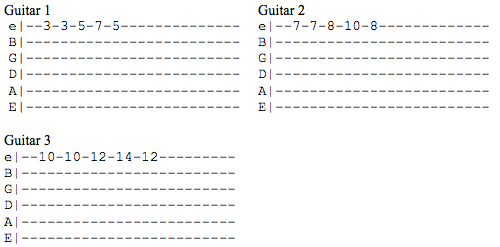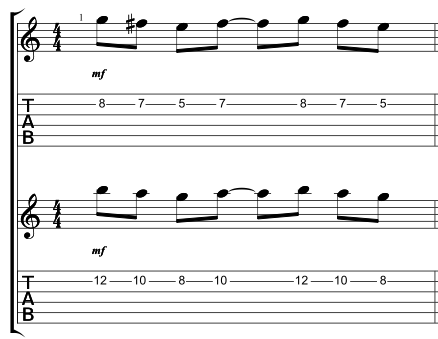How to Write Guitar Harmonies Like Iron Maiden
In this article, we’re going to look at how to write lead guitar harmonies, just like Iron Maiden play. Part of Iron Maiden’s iconic sound is the use of lead guitar harmonies, and we are going to completely unlock how they work, so that you can use them in your own music.
In this lesson we will cover:
- How to understand the basic theory required to write lead guitar harmonies.
- Examples for writing lead guitar harmonies.
- Shortcuts you can use to write lead guitar harmonies really, really fast.
- Two simple ideas for writing the rhythm guitar backing for a lead guitar harmony.
After working through this lesson, you will find yourself with a powerful new tool in your songwriting tool box and you will be able to easilly incorporate lead guitar harmonies into your songwriting.
We’ll also look at a technique that will help make your lead guitar harmonies sound even more exciting, but first, let’s get started with the basics.
What is Harmony?
Harmony is the vertical element of music. It’s all the notes that are sounding simultaneously. The study of harmony tells us what notes sound “good” when they are used together, and how we can use them.
When we write an Iron Maiden style lead guitar harmony, we are stacking two lead guitar melodies on top of each other.
The distance between any two notes is called an “interval”. When we write a lead guitar harmony, we have to be careful to use the correct intervals. This is how we get the harmony to sound good.
There are two types of interval, “consonant” and “dissonant”. Consonant intervals sound good together, and dissonant intervals either sound bad, or, we have to be very careful how we treat them.
Here is a table showing consonant and dissonant intervals:
| Consonant | Dissonant |
|---|---|
| Thirds | Seconds |
| Fourths* | Sevenths |
| Fifths | Any diminished / augmented interval |
| Sixths | |
| Octaves / Unison |
Fourths has an * because in some situations it is treated as dissonant. For the purposes of what we are doing today, we will consider it consonant.
For today, we’ll look at using thirds and fifths. Once you have seen the process, you will be able to apply it to any interval you want.
As a side note, that Iron Maiden dual guitar sound tends to come from using thirds.
Writing a Lead Guitar Harmony Using Thirds
Let’s say we start in the key of G major:
G A B C D E F#
And we have written a melody that uses the following notes:
G G A B A
And that we are playing the melody on guitar like this:

A guitar tab for the original melody. Note there are multiple ways we can play this on guitar.
To write a lead guitar harmony for this melody, we will take each note in the melody and replace it with the note a third up in the G major scale:
| Original Note | Third Up in Scale |
|---|---|
| G | B |
| A | C |
| B | D |
And if we take these notes and order them according to the original melody we get:
Original melody: G G A B A
Lead harmony: B B C D C
And if we write it out in guitar tab:

And that’s it. You can apply this technique to any guitar melody. The important thing is understanding what scale you are currently playing in. This is one advantage to learning music theory - you will understand how scales work together.
Writing a Lead Guitar Harmony in Fifths
The previous example looked at using an interval of a third for the harmony part. In this example, we will look at using an interval of a fifth.
The process is exactly the same, but we’ll walk through it step by step again.
So starting with the key of G major:
G A B C D E F#
And using the following melody:
G G A B A
which we will play on guitar like this:

This is the melody we used in the previous example.
This time, we will harmonise each note in the scale, with the note that is a fifth higher:
| Original Note | A Fifth Higher |
|---|---|
| G | D |
| A | E |
| B | F# |
So now our two melodies will look like this:
Original Melody: G G A B A
Harmonised with 5th: D D E F# E

Summary So Far
So there we have two basic concepts for writing lead guitar harmonies. Iron Maiden usually harmonise using 3rds. 5ths also sound great.
A great exercise would be to try recording the two examples that we’ve looked at so far - there are some audio examples coming up later.
You could also try writing some examples of your own.
Most of the guitar harmonies you hear in rock and metal music use the above methods, but there are a few more things we can do, so let’s take a look at those…
Using Thirds and Fifths in a Lead Guitar Harmony
We’ve looked at thirds… we’ve looked at fifths… what if we use both at once?
If we put the three melodies we now have (original, thirds and fifths) into one tab, we get the following:

Guitar 1: Original Melody, Guitar 2: Melody a Third Higher, Guitar 3: Melody a Fifth Higher
If we write out the notes in each melody in a table, we can see how they are harmonising together:
| Original Melody | G | G | A | B | A |
|---|---|---|---|---|---|
| Harmony a Third Higher | B | B | C | D | C |
| Harmony a Fifth Higher | D | D | E | F# | E |
Something you might notice from this table is that at any given point in time, the total harmony of the notes sounding is either a G major chord, A minor chord or B minor chord. Which would make sense - we used thirds and fifths to harmonise the melody, and thirds and fifths are the intervals that make up major and minor chords.
There are a couple of ways that, having three guitar harmonies, you can approach using them.
You can have all three play at once. Or, you could layer how they are introduced.
You could start with the original melody for a few repeats, then introduce harmony 1, then introduce harmony 2. Or have them all simultaneously… there are several ways you could arrange this! If you only have two guitar players, you could move through the guitar harmonies like this:
| Guitar 1: | Original Melody | Original Melody |
|---|---|---|
| Guitar 2: | Harmony 1 (thirds) | Harmony 2 (fifths) |
Or maybe you could try something like this:
| Guitar 1: | Original Melody | Original Melody | Harmony 1 (thirds) |
|---|---|---|---|
| Guitar 2: | Harmony 1 (thirds) | Harmony 2 (fifths) | Harmony 2 (fifths) |
I’m just brainstorming ideas here, there is no ‘rule’ for how to use these - have an experiment with some ideas of your own and see what you like the sound of.
What Shortcuts Can We Use For Writing Guitar Harmonies?
The method we have looked at so far involves:
- Writing a melody
- Working out the notes in that melody
- Working out the notes that will harmonise with those notes
- Working out how to play those notes on guitar
Now this process works - but it is a bit laborious. I remember the first time I did this with a band I was playing in yers ago, I spent about two hours working out a harmony for something we were doing.
It was incredibly exciting to hear it played with the band… but was there a faster way to get the same result?
Yes there is a much faster way to get to the same result… if you know 3 note per string scale patterns. If you don’t know these scale patterns, I highly recommend you learn them. Apart from being great for shredding on guitar, they are very powerful tools.
If we take the melody we used at the start of this article:

This is our original melody.
We can “map out” that melody on a 6 string 3 note per string major scale:

Note that some people (including myself in the past) refer to this as the “Locrian Mode”. This is not the Locrian Mode, it is the 7th position of the major scale. But getting into why that is the case is a subject for another day.
Let’s assume we want to harmonise the melody in thirds. To do this, we are going to look at the scale position that is a third up from the scale position that we started in.
We start in position 7, so a third up will be position 2:

To play the harmony, we play through the notes in blue in the second position, in the same order (or pattern) as we play the notes in the first position.
As another side note, this demonstrates the power of thinking about guitar scales and theory in terms of patterns, rather than as frets, and another great reason to learn your scale patterns on guitar.
Let’s get back to writing harmonies.
If you wanted to write the harmony in fifths, we would start at the 7th positions, and go up 5 positions, giving us position 4:

So as you can now see, if you understand your scales on guitar well, you can write harmonies like this on the spot. This is a very cool ability to have either just for yourself writing your own music, or when songwriting with friends in your band.
Ideas for Combining Lead Guitar Harmonies with Rhythm Guitar
We’ve now extensively covered how to write lead guitar harmonies, the theory behind them and some shortcuts you can use. So I thought next we would look at some ideas we can use with the rhythm guitars.
We will look at two different ideas. For both ideas, we will use the following melody and harmony part:

Here is what the two lines sound like when recorded together:
The lead guitar harmony from the tab above.
Let’s say that we are playing this lead guitar part over an E5 power chord. Here is what that sounds like when repeated a couple of times in a row:
The lead guitar harmony over an E5 power chord.
This already sounds quite cool. However, we could make this sound more interesting by adding some different power chords.
We are in the key of E minor, which will have the following power chords:
E5 F#dim G5 A5 B5 C5 D5
Learn more: Learn about minor key chord progressions you can use for your harmonies here.
Let’s take some of these power chords, write some progressions and see how they come out with the lead guitar harmony that we wrote:
Progression 1: E5 - G5 - D5 - C5
Lead guitar harmony with power chords from progression 1.
Progression 2: E5 - A5 - G5 - F#dim
Lead guitar harmony with power chords from progression 2.
Progression 3: E5 - A5 - C5 - B5
Lead guitar harmony with power chords from progression 3.
If you are writing for two guitars, rather than power chords behind the melody, you could have the bass guitar just playing the root notes of the power chords.
Conclusion
There are a lot more ideas and variations we can experiment with when looking at this topic.
Hopefully after working through the above examples, you have a clear understanding of:
- What a lead guitar harmony is.
- How you can write lead guitar harmonies.
- A simple shortcut using 3 note per string scales to write harmonies on the spot.
- How to write a simple rhythm behind the harmonies.